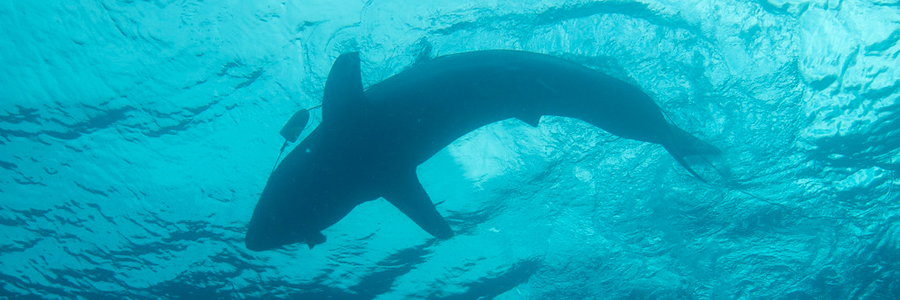FAQ: Should You Be Scared About More Sharks in the Bay?

Update: The California Department of Fish and Wildlife (CDFW) has issued a reminder that White Sharks are a protected species under both state and federal fisheries laws and regulations.
An increase in shark sightings in Southern California – and even some beach closures – have raised long-standing concerns among many ocean users. Here staff scientist Dana Murray Roeber separates fact from fiction.
Why are we seeing reports of white sharks in the Bay?
Santa Monica Bay is home to dozens of species of sharks and rays. Many of them are small, like the swell shark and horn shark, and live in kelp forests and rocky reefs. Juvenile great white sharks are seasonal residents of Southern California’s coastal waters, likely congregating in Santa Monica Bay due to a combination of abundant prey and warm water as summer comes. White sharks are frequently spotted by boaters, pier-goers, surfers and paddlers – especially between the surf spot El Porto and the Manhattan Beach Pier. Juvenile white sharks, measuring up to 10 feet long, prey mostly on bottom fishes such as halibut, small rays and other smaller sharks. Progress to protect marine species has advanced over the past 50 years, including protections for marine mammals, an important food source for adult white sharks. These protections have likely led to a healthier and growing population of white sharks and marine mammals alike, which is a good sign for our oceans.
Is it a good or bad thing there are so many of them in the water?
Sharks are at the top of the food chain in virtually every part of every ocean. They keep populations of other fish healthy and ecosystems in balance. In addition, a number of scientific studies demonstrate that the depletion of sharks can result in the loss of commercially important fish and shellfish species further down the food chain, including key fisheries such as tuna.
Where are they coming from and where are they going?
White sharks usually migrate south in the winter when California’s coastal waters drop below 60 degrees. However, our local ocean waters stayed warmer in 2014-16 due to El Niño-like conditions and climate change. Again this winter, it is believed that most of the juvenile white sharks didn’t leave Southern California.
What are the popular spots from them in So Cal?
White sharks are congregating in shallow waters off Huntington Beach, San Onofre, Long Beach, Santa Monica Bay and Ventura.
What are the real dangers to humans?
There is always a risk when entering the habitat of a large predator – whether in the ocean, or the African savanna, or Kodiak Island. Poor water quality, powerful waves, strong currents and stingrays pose a greater threat to local ocean-goers than sharks.
How can I avoid sharks in the sea?
According to the Department of Fish and Wildlife, there have only been 13 fatal white shark attacks in California since the 1920s. Eating a hot dog poses a greater danger to life and limb than any shark. If you’re still concerned, here are some quick tips to avoid run-ins with fins:
- Avoid waters with known effluents or sewage.
- Avoid areas used by recreational or commercial fishermen.
- Avoid areas that show signs of baitfish or fish feeding activity; diving seabirds are a good indicator of fish activity.
- Do not provoke or harass a shark if you see one!
What should you do and what shouldn’t you do if you think you see a shark?
First, assess the risk. If you see as small horn shark or thornback ray, it is safe to swim in the area. But keep your distance from the animal. If a larger shark is spotted, it is best to evacuate the water calmly, trying to keep an eye on the animal. Do not provoke or harass the shark. Report your shark sighting, with as much detail possible, to local lifeguards. If you or a companion are one of the very, very few people each year bitten by a shark, experts advise a proactive response. Hitting a shark on the nose, ideally with an inanimate object, usually results in the shark temporarily curtailing its attack.
Why are many species of sharks protected?
Despite popular perceptions of sharks being invincible, shark populations around the world are declining due to overfishing, habitat destruction and other human activities. It is estimated that over 100 million sharks are killed worldwide each year. Of the 350 or so species of sharks, 79 are imperiled according to the International Union for the Conservation of Nature. There are several important spots for Northeastern Pacific white sharks in California, yet they are vulnerable to ongoing threats, such as incidental catch, pollution and other issues along our coast. White shark numbers in the Northeastern Pacific are unknown but are thought to be low, ranging from hundreds to thousands of individuals. They’re protected in many places where they live, including California, Australia and South Africa. It is illegal to hunt, pursue, catch or kill a great white shark in California, with anyone caught causing harm liable to criminal prosecution.
Can I fish for white sharks in California?
Federal regulations implemented in 2004 prohibit white shark retention in California, requiring their immediate release if caught. Additionally, in 1994, white sharks received special protected status in California State law, which prohibits take of white sharks except by special permit and some commercial incidental take allowances. State of California regulations also protect white sharks from recreational fishing. Under these protections, it is illegal to fish for or pursue white sharks, and they must be released immediately if caught inadvertently while fishing for other species.



